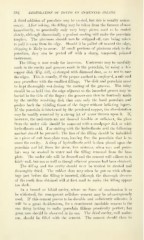Page 386 - My FlipBook
P. 386
384 RESTORATION OF TEETH BY CEMENTED INLAYS.
A third addition of porcelain may be needed, but this is usually unnec-
essary. After baking, the filling may be taken from the furnace almost
immediately, as practically only very large pieces need to be cooled
slowly, although theoretically a gradual cooling will make the porcelain
tougher. The platinum should now be stripped off, care being taken
to pull it away from the edge. Should it be pulled off' toward the edge,
chipping is likely to occur. If small portions of platinum stick to the
porcelain, they can be peeled off with a sharp, tempered, pointed
instrument.
The filling is now ready for insertion. Undercuts may be carefully
made in the cavity and grooves made in the porcelain, by using a thin
copper disk (Fig. 352, a) charged with diamond dust, so as not to mar
the edges. This is usually, if the proper method is employed, a safe and
easy procedure with the smallest fillings. The disk and porcelain must
be kept thoroughly wet during the cutting of the grooves. The inlay
should be so held that the edge adjacent to the intended groove may be
buried in the skin of the finger ; the groove can then be fearlessly made
by the swiftly revolving disk that cuts only the hard porcelain and
pushes back the yielding tissue of the finger without inflicting injury.
If the porcelain is blackened by the powdered copper, the discoloration
may be readily removed by a strong jet of water thrown upon it. If,
however, the undercuts are not deemed feasible or sufficient, the gloss
from the under side should be removed with a sandpaper disk or with
hydrofluoric acid. For etching with the hydrofluoric acid the following
method should be pursued : The face of the filling should be imbedded
in a piece of soft base-plate wax, leaving free the porcelain that is to
enter the cavity. A drop of hydrofluoric acid is then placed upon the
porcelain and left there for about five minutes, when wax and porce-
lain may be washed in water and the filling removed from the base
plate. The under side will be frosted and the cement will adhere to it
fairly well, but not so well as though efficient grooves had been obtained.
The filling and the cavity should next be washed in alcohol and
thoroughly dried. The rubber dam may often be put on with advan-
tage just before the filling is inserted, although the thorough dryness
of the tooth thus obtained will at first tend to make the filling appear
too dark.
In a buccal or labial cavity, where no force of mastication is to
be withstood, the transparent cellulose cement may be advantageously
used. If this cement proves to be durable and sufficiently adhesive it
will be a great desideratum, for a translucent insoluble cement is the
one thing lacking to make porcelain fillings practically perfect; but
great care should be observed in its use. The dried cavity, well under-
cut, should be filled with the cement. The cement should then be


